Our hair colors to gray hair
Here you will find an explanation of the different colors. A natural color is a color that does not contain a dot and numbers behind it. This will always cover gray hair better and provide better durability. A reflective color is a color that has numbers behind the dot in cold or warm shades. Lengths and ends always attract more color and therefore we recommend a lighter shade in the lengths for an even result from root to tip.
 | No. 10 - Very Light Blonde |
 | No. 9 - Light Blonde |
 | No. 8 - Blonde |
 | No. 7.1 - Cold Dark Blonde |
 | No. 6 - Light Brown |
 | No. 5.1 - Cold Brown |
 | No. 4 - Dark Brown |
 | No. 1/2 - Black |
The images show color references to help you choose the right shade. If you are unsure which color is best for you, we recommend that you contact By Bente for guidance.
There is a big difference between coloring uncolored hair and hair that has already been treated.
Uncolored hair needs more pigment, i.e. a darker color and a longer exposure time than already treated hair. The main reason for this is that treated hair is already open so the pigments are absorbed into the hair faster. While uncolored hair needs time to open. Already colored/lightened hair will therefore always be darker than uncolored hair if you use the same hair color and the same exposure time on the entire hair.







